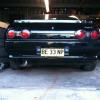Turbo Identification Help.
Announcements
-
Similar Content
-
Latest Posts
-
As you're looking at using a Link ECU, then large injectors are not a problem. But there's not really any need to go 1000s on an RB20 unless you're planning >>600HP on E85, which would seem unlikely. There are other options for injectors. The Xspurt ones are available from a number of places and you can get them in the mid 600s and 725cc, which is probably a sensible place to be. These are all EV14 based. If you are not using the stock AFM (at all, which would be the case with a Link) then a large turbo intake pipe to suit the ATR turbos is not an obstacle, so you should use one instead of a highflow. Results will be better.
-
Hey guys, I'm after some advice and this here is the best place to get it imo. I was a member a looong time ago under another account, with a lost email address. Its nice to jump back on and see some of the same names still giving good advice. I mothballed my car when i moved to perth in 2013, and after getting towed across the nullabor a few times it has officially done more km's on a trailer than under its own power. Now that i have started the process of tidying up and modifying it, i see the fruit available (and the fruiterers selling the produce) is different than back in the day. hence my questions, as i used to 'know' what to get and now, i'm not so sure. Engine wise the car (92 gtst) has a walbro 255, k+n, fmic, cam gears and and turbo back 3"exhaust. Wish list is a Hypergear high flow or ATR43G1, Link G4x and some newer injectors before a tune up. My goals are modest, only low 200's power wise. i know i could achieve this with less, but i've been swapping out old for new where i can. Every cooling hose has been replaced, along with mani gaskets, WP, thermostat and radiator, fuel pump and timing belt, tensioner and idler, and i rebuilt the steering rack. Regarding the injectors, the fruiterers all seem to sell what used to be considered quite large injectors. There are a lot of options for bosch 1000cc EV14's, and i would like to know if that is a suitable choice for my build. Is modern injector design good enough to run these at the low duty cycles that i likely would be? is there a downside to running a too large injector these days? or, would there be an upside to running a smaller injector at higher duty cycle? I can see that there are smaller injectors still available, but the ones i have seen specifically marketed for RB's are pretty large (see: https://golebysparts.au/collections/fuel-rail-injector-kits/products/nissan-rb20-fuel-rail-bosch-980cc-1150cc-injectors-turbosmart-fpr800-regulator-kit), and i dont know enough about them to say one not marketed for RB's would fit or not. I have searched the forums, and amongst all the posts on older tech, I did see gtsboy recommend EV14's, but no size was mentioned... again, i'm not clear on if the smaller size bosch injectors are also EV14's as they do look similar. also, if someone can recommend a tuner familiar with RB's in the Geelong or West Melbourne area i'd appreciate it. Thanks in advance guys. Cheers, Rowdy
-
FWIW the depth of the groove in the rubber pad is not super essential, the blocks are rubber and squish a bit. If you are worried an angle grinder will make a deeper groove quick smart
-
I mean, if you were to move the jacking points away from the original location, that is, away from the wheels and closer to the centreline of the car, then it will be more likely to overbalance and tip off the supports. Same as we talked about before. I was talking about moving for-aft. If the sill is bent outward or inward, then the car would obviously look unstraight from the outside. Hopefully that hasn't happened either. Again, you can do comparative measurements from the chassis rails to see if there is much deflection.
-
Can you elaborate what you mean with your first sentence? I meant move as in the bulge kinda seemed like it got pulled "outward" meaning it got pulled down and to the side with the jacking rail itself, so the load bearing bulge now sits lower than usual and is not level with the sill on the other side of the jack point. Either that or the jacking rail just got pushed in a good bit.
-




Recommended Posts
Create an account or sign in to comment
You need to be a member in order to leave a comment
Create an account
Sign up for a new account in our community. It's easy!
Register a new accountSign in
Already have an account? Sign in here.
Sign In Now